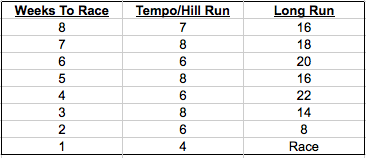
Whether you are coming back from injury or just realized you only have a few weeks left to race day, your problem is the same question I receive almost daily via email: How can I modify my training plan to get ready for my next marathon in a short time frame?
I get this question because Marathon Nation is known for choosing quality training over quantity; we train this way because it yields maximum results in minimum time. But let's be clear that there are no shortcuts. The plans aren't easy. At the end of the day you still need to be able to run 26.2 miles well, regardless of what training program you follow.
If your training window is small, know that picking up the traditional plan won't do much good, as the mileage mere weeks before race day is pretty darn beefy. Often to the tune of 18, 20, or even 22 miles. There's just no way you can leap into that type of a run (or training week) without the proper preparation. You are risking your health and potentially creating some serious fatigue that will linger until the big day.
Here's the official Marathon Nation guidance on how to add miles to a marathon training program within a compressed time frame.
Step One: Identify the Key Runs
Between now and your marathon, you have a ton of runs on your schedule. Right away the long runs are "key," so circle all of them. Then pick one more set of runs: if the race is hilly then hill work is important. If the race is flat then tempo runs (not track work) is important. Do the math back from race day to identify just how many of these runs you will be able to get (assuming one each per week).
Step Two: Build A Basic Week
Let's assume you have 8 weeks until race day, leaving you with 8 weeks of runs. Technically not an equal 8 weeks, however, as you'll need to taper down the long run pre-race?so know that the early runs are more important to get done than the later ones (you are motivated, right!?).
Map out your 8 Weeks into a simple sheet. As in the example below. This will really give you a sense of just what you'll need to do to be ready, at a minimum, to complete your race.
Then build an actual weekly table that fits into your current life / training cycle. Again, I have provided an example here for you to work off of.
Note that the tempo or hill run is on Tuesday, after a day of cross training and before a day off. This means it will be a run you can hit on all cylinders. Then the long run run is on Saturday, also preceded by cross training and followed by a day off. The new run on the schedule, Thursday, is essentially 50% of your long run volume for that weekend.




